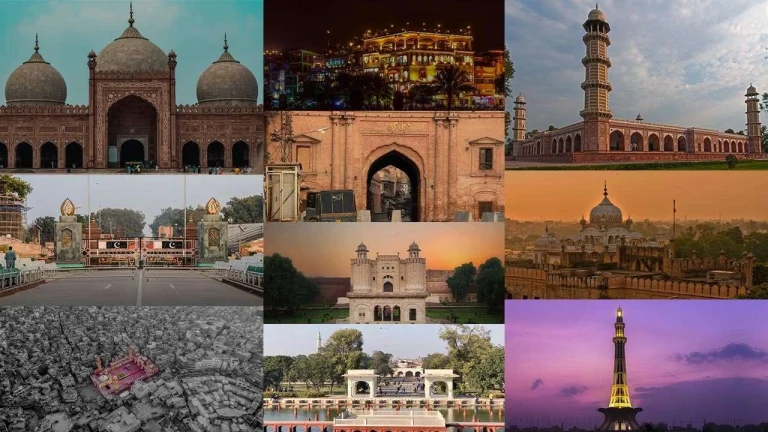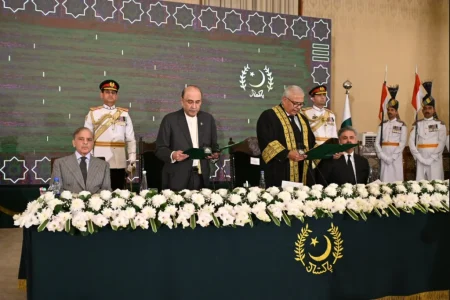Lahore, the cultural heart of Pakistan, is a city steeped in history, art, and architectural grandeur. From the majestic Mughal-era forts to intricately designed tombs and vibrant gardens, the city offers a captivating journey through time. Each historical site in Lahore tells a story of emperors, saints, and artists who have shaped the city’s rich heritage. Whether you are a history enthusiast, a tourist, or a local exploring your roots, these 10 must-visit historical places provide a perfect glimpse into Lahore’s glorious past and timeless charm.
1) Data Darbar
Data Darbar is the largest Sufi shrine in South Asia, built to honor the 11th-century Sufi saint Ali Hujwiri, popularly known as Data Ganj Bakhsh. Originally a simple grave near his mosque, it was expanded during the Mughal era and further developed in the 19th and 20th centuries. The shrine hosts millions of visitors annually, especially during the urs festival.
Location: H8H4+J6C, Data Darbar Rd, Data Gunj Buksh Town, Lahore, 54000, Pakistan
Architecture:
The tomb is constructed in Mughal-style white marble, surrounded by a large marble courtyard. The shrine complex also features modern additions like a mosque, educational institutions, and spaces for qawwali performances, blending traditional and modern architectural elements.
Opening Hours: Open 24 hours,
Tickets: Free Entry
Contact Information: 04237230537
Reviews: 4.7 (11,630 reviews)
2) Lahore Fort (Shahi Qila)
Lahore Fort, also known as Shahi Qila, is a historic citadel in Lahore dating back to the 11th century, with major expansions during the Mughal era. It is a UNESCO World Heritage Site and represents a fine example of Mughal architecture, featuring majestic halls, gates, gardens, and palaces. The fort served as a residence for Mughal emperors and remains a symbol of Lahore’s rich history.
Location: H8Q7+56P, Fort Rd, Walled City of Lahore, Lahore, Pakistan
Architecture:
The fort showcases Mughal architecture with elaborate frescoes, marble inlays, massive gateways like Alamgiri Gate, Shish Mahal (Palace of Mirrors), and Diwan-i-Aam (Hall of Public Audience). The surrounding gardens, ponds, and defensive walls highlight the grandeur of the Mughal era.
Opening Hours:
Monday-Sunday: 8:30 AM – 5:00 PM
Contact Information: 04299204196
Reviews: 4.6 (25,747 reviews)
3) Lahore Museum
Lahore Museum is one of Pakistan’s largest and oldest museums, showcasing the country’s rich cultural heritage. Its extensive collection includes ancient artifacts, Gandhara sculptures, Mughal and Sikh-era relics, manuscripts, coins, and contemporary art, making it a hub for history enthusiasts and researchers alike.
Location: H895+93H, Mall Rd, Anarkali Bazaar Lahore, 54000, Pakistan
Architecture:
The museum building features Indo-Saracenic architecture, with red brick walls, arched entrances, and spacious halls that provide a grand yet organized display of its diverse collections.
Opening Hours:
Monday-Sunday: 9:00 AM – 5:00 PM
Contact Information:
Website: https://lahoremuseum.punjab.gov.pk/
Phone: 0429 9211819
Reviews:
4.5 (9,324 reviews)
4) Delhi Gate
Delhi Gate is a historic gateway originally built during the Mughal period. Today, it serves as a 2-story landmark and houses a small market, reflecting the vibrant culture of Lahore’s Walled City.
Location: Inside Delhi Gate, Akbari Mandi, Walled City of Lahore, Lahore, 54000, Pakistan
Architecture:
The gate features classic Mughal architecture with large arched entrances and fortification elements. The 2-story structure includes small shops and a market inside, preserving its historical charm.
Opening Hours: Open 24 hours
Reviews: 4.6 (20,176 reviews)
5) Sheesh Mahal Lahore
Built in 1632 during the reign of Mughal Emperor Shah Jahan, Sheesh Mahal (Palace of Mirrors) was part of the Lahore Fort complex. It was designed as a private pavilion for the royal family and court nobles. The palace is famous for its intricate glasswork and mirror mosaics, reflecting the grandeur and luxury of Mughal court life. Over centuries, it has remained a symbol of Lahore’s rich cultural heritage and Mughal architectural excellence.
Location: H8Q7+X7F, Walled City of Lahore, Lahore, Pakistan
Architecture:
Sheesh Mahal is a masterpiece of Mughal architecture, featuring white marble walls inlaid with colored stones and intricate mirror work that creates dazzling reflections. The pavilion has a series of arched windows and niches decorated with frescoes and pietra dura. The ceiling is adorned with mirrored panels and delicate floral motifs. The palace’s layout reflects the Mughal emphasis on symmetry, aesthetics, and integration with the surrounding Lahore Fort complex.
Opening Hours: Monday-Sunday: 9:00 AM – 5:00 PM
Reviews: 4.5 (1,092 reviews)
6) Haveli Nau Nihal Singh
Haveli Nau Nihal Singh is a historic mansion from the early 19th century, built during the Sikh era in Lahore. It was the residence of Nau Nihal Singh, a prominent Sikh ruler. The haveli showcases the lifestyle of Lahore’s elite during the Sikh period, combining residential comfort with artistic expression.
Location: H8H6+VG9, گلی بازار, موری Mohalla Sathan, Walled City of Lahore, Lahore, 54000, Pakistan
Architecture:
The haveli is a two-story structure with traditional courtyards, carved wooden balconies, and intricately painted walls and ceilings. Frescoes inside depict floral motifs, court scenes, and Sikh-era designs. The haveli’s layout emphasizes ventilation and natural light, while the decorative art highlights the fusion of Mughal and Sikh influences.
Opening Hours:
Open 24 hours
Reviews: 4.5 (277 reviews)
7) Tomb of Emperor Jahangir
Constructed in 1637 by Empress Nur Jahan, the Tomb of Emperor Jahangir is located in Shahdara Bagh, Lahore. Jahangir was the fourth Mughal emperor, known for his love of art, culture, and gardens. The tomb was built to honor his legacy and is a significant example of Mughal funerary architecture.
Location: Ali Hajveri Street, Jahangir Tomb Rd, near Ali Hajvari Mosque, Lahore, Pakistan
Architecture:
The tomb is built from white marble and red sandstone, featuring a central dome and symmetrical gardens in the Charbagh style. The interiors are decorated with frescoes and intricate floral designs. The mausoleum rests on a raised platform and is surrounded by smaller pavilions and gateways.
Opening Hours:
Monday-Sunday: 9:00 AM – 7:00 PM
Reviews:
4.5 (2,855 reviews)
8) Shalamar Gardens
Shalamar Gardens were built in 1641 by Mughal Emperor Shah Jahan as a pleasure garden for the royal family. The gardens are an example of Mughal landscape design and have been recognized as a UNESCO World Heritage site. Historically, they served as a retreat for the royal court and were designed to demonstrate Mughal power, aesthetics, and mastery of horticulture.
Location: AH1, GT Rd, Shalamar Town, Lahore, 54000, Pakistan
Architecture:
Shalamar Gardens follow the Charbagh layout, divided into three descending terraces. Water flows through canals, fountains, and cascades connecting the terraces. The gardens feature pavilions, decorative gateways, and shaded areas for relaxation. Mughal engineering ensured precise water flow and symmetry, creating a harmonious blend of natural beauty and architectural elegance. Opening Hours:
Monday-Sunday: 9:00 AM – 6:00 PM
Reviews:
4.5 (4,883 reviews)
9) Faqeer Khana Museum
Faqeer Khana Museum is a heritage museum located in the Walled City of Lahore, inside the historic Faqeer Khana Haveli. The museum was established in the 19th century and houses a vast collection of antiques, manuscripts, and artifacts collected over generations by the family residing in the haveli. It preserves the cultural and historical heritage of Lahore, including items from the Mughal and Sikh eras.
Location: Hakiman Bazar, Kucha Faqirkhana, Kucha Astana Sharif, Walled City of Lahore, Lahore, 54000, Pakistan
Architecture:
The museum is housed within a traditional haveli, featuring intricately carved wooden doors, latticed windows, and inner courtyards. The architecture reflects Mughal and Sikh influences, with frescoed walls, decorative arches, and high ceilings. The building is organized around central courtyards, allowing natural light and ventilation to illuminate the antique collections.
Opening Hours:
Monday-Sunday: 10:00 AM – 5:00 PM
Contact Information:
+92 300 4131809
Website: fakirkhana.com
Reviews:
4.4 (820 reviews)
10) Bab-e-Pakistan
Bab-e-Pakistan is a monument built to commemorate the Pakistani migrants (Muhajirs) who moved from India during the 1947 partition. Located in Walton Road, Lahore, it symbolizes the struggles, hopes, and resilience of the migrants who contributed to the establishment of Pakistan. The monument has become a key historical and cultural landmark, representing the nation’s post-independence history and the collective memory of migration.
Location: F9J3+QC3, Walton Rd, Nishtar Town, Lahore, Pakistan
Architecture:
The monument features a modernist design with clean lines and geometric patterns. Its structure is primarily made of reinforced concrete, with symbolic inscriptions and engravings representing the migration journey. Surrounding the monument is a landscaped park where visitors can walk and reflect.
Opening Hours:
Open 24 hours
Contact Information:
Website: bepf.punjab.gov.pk
Reviews:
4.1 (1,065 reviews)







